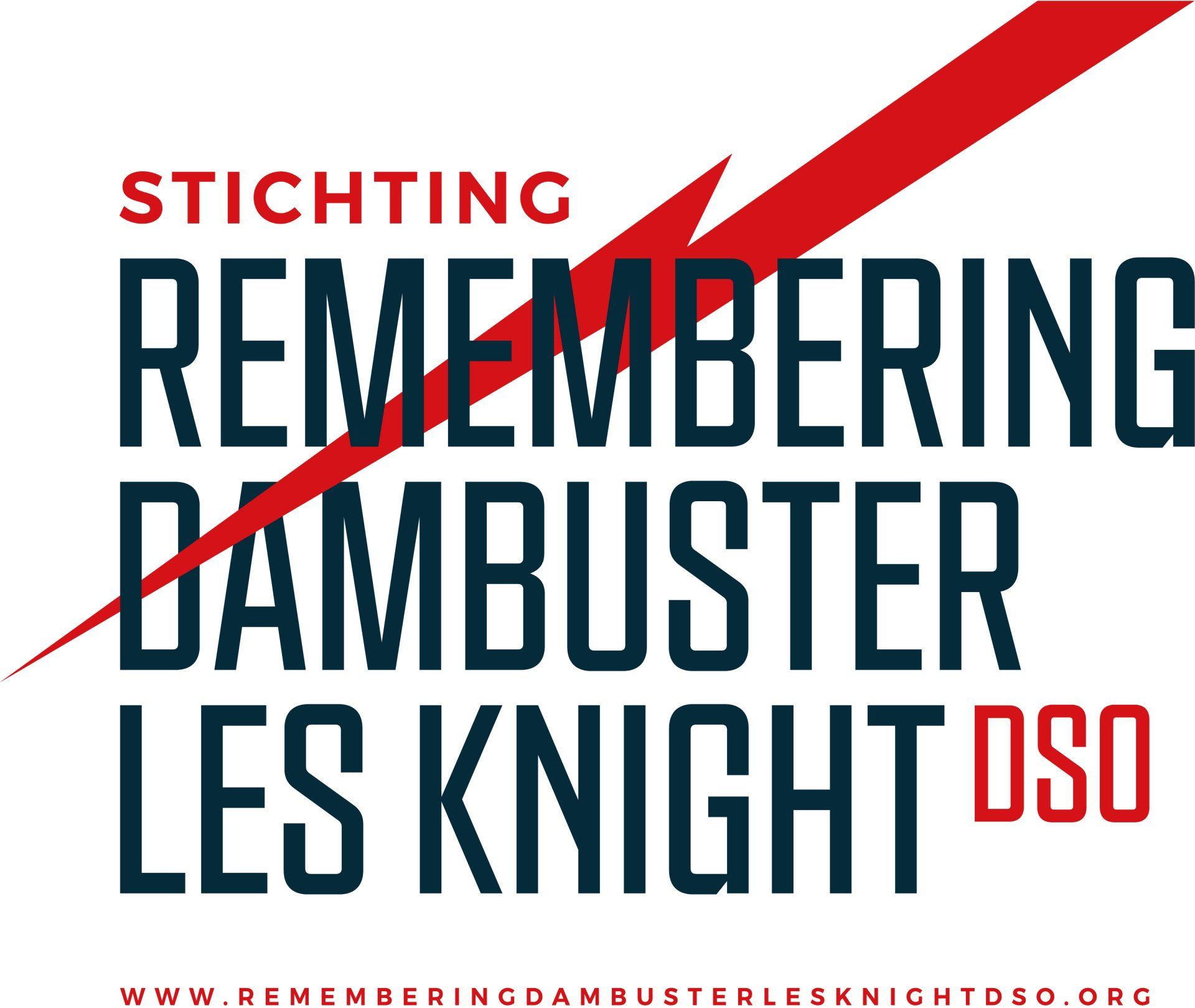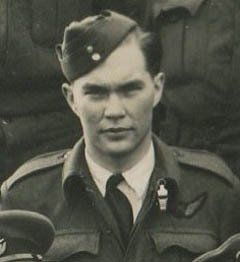More Info Fred Sutherland
More Info Fred Sutherland
Fred Sutherland in 617 Squadron, July 1943
Sgt F E Sutherland
Front gunner
Lancaster serial number: ED912/G
Call sign: AJ-N
First wave. Third aircraft to attack Eder Dam. Mine dropped accurately causing final breach.
Frederick Edwin Sutherland was born in Peace River, Alberta, Canada on 26 February 1923, the only boy in a family of the three children of Dr Frederick Henry Sutherland and his wife, Clara. His father was a doctor and his mother was a nurse. From a young age, he had wanted to fly and had dreams of becoming a bush pilot, but the war put paid to that. So he joined the RCAF in 1941, as soon as he turned 18. After initial training he volunteered for air gunner duties.
He arrived in England in 1942, and crewed up with Les Knight and his future colleagues at a training unit before they were all posted to 50 Squadron in September of that year. He flew on 25 operations with Knight before the whole crew volunteered to transfer to the new 617 Squadron in March 1943.
Like most of the squadron he had no idea what the target was to be until he walked into the briefing room hours before take off on 16 May 1943. When he saw the scale model of the Möhne Dam, the first thing he noticed were the 20-millimetre gun posts at either end of the dam. ‘I immediately thought we didn’t have a hope,’ he said recently.
After the Möhne was breached and the crew moved on to the Eder, he realised how difficult the attack was going to be:
We were all afraid of the hill. We had to drop the bomb at the right distance and the right height, and then to make it [Les] had to push the throttles right through the gate, which is not supposed to be done… I didn’t see anything when the bomb went off because I was in the nose, but I heard the rear gunner saying ‘it’s gone, it’s gone’.
After the raid, Les Knight, Sidney Hobday and Johnny Johnson were decorated. Knight was embarrassed that the whole crew had not been rewarded, Sutherland recalled. ‘He felt badly that half the crew got decorated, the other half didn’t. He said you know I’m wearing the DSO for all you guys, you all did something for it.’
On the fateful Dortmund Ems raid in September, Knight’s crew were in the formation of four aircraft led by the new squadron CO, George Holden. As they flew over the small town of Nordhorn in Holland, Holden was hit by flak, and his aircraft exploded. On board were four of Gibson’s Dams Raid crew, including fellow Canadians, Terry Taerum and George Deering. Sutherland in the front turret saw everything:
It was so close I could almost reach out and touch it. Your friends are getting killed and you are scared as hell but you can’t let it bother you because if you did, you could never do your job. All you can do is think, ‘Thank God it wasn’t us.’
Hours later, Sutherland was himself on Dutch soil, having parachuted to safety after being ordered by Knight to bale out. After being hidden by a friendly Dutch farmer, he was put in touch with the underground network, and met up with Sydney Hobday. The two were smuggled all the way through Belgium and France to Spain.
At one point while on a train, using forged documents provided to him by the underground, he duped a German officer who inspected his fake passport. Suspicious, the officer held the passport up to the light and scrutinized it painstakingly, trying to determine if it was forged. ‘I had to ball up my fists to keep him from seeing how much my hands were shaking,’ he recalled.
After getting back to the UK he was sent home to Canada in 1944. Greeted in Edmonton by his girlfriend, Margaret Baker, he proposed immediately. Terry Taerum’s mother found out that he had been posted back to Canada, and asked to meet him. She wanted to know whether her son had any chance of escaping the blaze when his aircraft was hit. ‘Telling her about it was the hardest thing I ever had to do,’ he said recently.
Following the war, Sutherland stayed on in the RCAF for 12 more years, and was commissioned. He then studied forestry, and got a job with the forestry service. In 1964 he became forestry superintendent in Rocky Mountain House in his home province of Alberta, and he still lives in the area.
Fred Sutherland used the famous Chemin de la Liberté route in his escape through the Pyrenees, and in 2010, he paid a return visit to the area and met the people who keep the memories of the route alive.
Fred S. + Jo Salter
Fred Sutherland in 2010 on his return visit to the Chemin de la Liberté route, photographed with Jo Salter, the first woman to fly as a combat pilot with the RAF, and a fellow 617 Squadron veteran. [Pic: Scott Goodall]
More about Sutherland online:
Blog article and interview by Elinor Florence, 2015
Interview on CBC, May 2013
Interview and article, Edmonton Journal, Canada, November 2013
BBC Radio documentaries about the Chemin de la Liberté
Survived war.
Rank and decorations as of 16 May 1943.
Sources:
Richard Morris, Guy Gibson, Penguin 1995
John Sweetman, The Dambusters Raid, Cassell 2002
John Sweetman, David Coward and Gary Johnstone, The Dambusters, TimeWarner, 2003
The information above has been taken from the books and online sources listed above, and other online material. Apologies for any errors or omissions. Please add any corrections or links to further information in the comments section below.
Sgt F E Sutherland
Front gunner
Lancaster serial number: ED912/G
Call sign: AJ-N
First wave. Third aircraft to attack Eder Dam. Mine dropped accurately causing final breach.
Frederick Edwin Sutherland was born in Peace River, Alberta, Canada on 26 February 1923, the only boy in a family of the three children of Dr Frederick Henry Sutherland and his wife, Clara. His father was a doctor and his mother was a nurse. From a young age, he had wanted to fly and had dreams of becoming a bush pilot, but the war put paid to that. So he joined the RCAF in 1941, as soon as he turned 18. After initial training he volunteered for air gunner duties.
He arrived in England in 1942, and crewed up with Les Knight and his future colleagues at a training unit before they were all posted to 50 Squadron in September of that year. He flew on 25 operations with Knight before the whole crew volunteered to transfer to the new 617 Squadron in March 1943.
Like most of the squadron he had no idea what the target was to be until he walked into the briefing room hours before take off on 16 May 1943. When he saw the scale model of the Möhne Dam, the first thing he noticed were the 20-millimetre gun posts at either end of the dam. ‘I immediately thought we didn’t have a hope,’ he said recently.
After the Möhne was breached and the crew moved on to the Eder, he realised how difficult the attack was going to be:
We were all afraid of the hill. We had to drop the bomb at the right distance and the right height, and then to make it [Les] had to push the throttles right through the gate, which is not supposed to be done… I didn’t see anything when the bomb went off because I was in the nose, but I heard the rear gunner saying ‘it’s gone, it’s gone’.
After the raid, Les Knight, Sidney Hobday and Johnny Johnson were decorated. Knight was embarrassed that the whole crew had not been rewarded, Sutherland recalled. ‘He felt badly that half the crew got decorated, the other half didn’t. He said you know I’m wearing the DSO for all you guys, you all did something for it.’
On the fateful Dortmund Ems raid in September, Knight’s crew were in the formation of four aircraft led by the new squadron CO, George Holden. As they flew over the small town of Nordhorn in Holland, Holden was hit by flak, and his aircraft exploded. On board were four of Gibson’s Dams Raid crew, including fellow Canadians, Terry Taerum and George Deering. Sutherland in the front turret saw everything:
It was so close I could almost reach out and touch it. Your friends are getting killed and you are scared as hell but you can’t let it bother you because if you did, you could never do your job. All you can do is think, ‘Thank God it wasn’t us.’
Hours later, Sutherland was himself on Dutch soil, having parachuted to safety after being ordered by Knight to bale out. After being hidden by a friendly Dutch farmer, he was put in touch with the underground network, and met up with Sydney Hobday. The two were smuggled all the way through Belgium and France to Spain.
At one point while on a train, using forged documents provided to him by the underground, he duped a German officer who inspected his fake passport. Suspicious, the officer held the passport up to the light and scrutinized it painstakingly, trying to determine if it was forged. ‘I had to ball up my fists to keep him from seeing how much my hands were shaking,’ he recalled.
After getting back to the UK he was sent home to Canada in 1944. Greeted in Edmonton by his girlfriend, Margaret Baker, he proposed immediately. Terry Taerum’s mother found out that he had been posted back to Canada, and asked to meet him. She wanted to know whether her son had any chance of escaping the blaze when his aircraft was hit. ‘Telling her about it was the hardest thing I ever had to do,’ he said recently.
Following the war, Sutherland stayed on in the RCAF for 12 more years, and was commissioned. He then studied forestry, and got a job with the forestry service. In 1964 he became forestry superintendent in Rocky Mountain House in his home province of Alberta, and he still lives in the area.
Fred Sutherland used the famous Chemin de la Liberté route in his escape through the Pyrenees, and in 2010, he paid a return visit to the area and met the people who keep the memories of the route alive.
Fred S. + Jo Salter
Fred Sutherland in 2010 on his return visit to the Chemin de la Liberté route, photographed with Jo Salter, the first woman to fly as a combat pilot with the RAF, and a fellow 617 Squadron veteran. [Pic: Scott Goodall]
More about Sutherland online:
Blog article and interview by Elinor Florence, 2015
Interview on CBC, May 2013
Interview and article, Edmonton Journal, Canada, November 2013
BBC Radio documentaries about the Chemin de la Liberté
Survived war.
Rank and decorations as of 16 May 1943.
Sources:
Richard Morris, Guy Gibson, Penguin 1995
John Sweetman, The Dambusters Raid, Cassell 2002
John Sweetman, David Coward and Gary Johnstone, The Dambusters, TimeWarner, 2003
The information above has been taken from the books and online sources listed above, and other online material. Apologies for any errors or omissions. Please add any corrections or links to further information in the comments section below.

